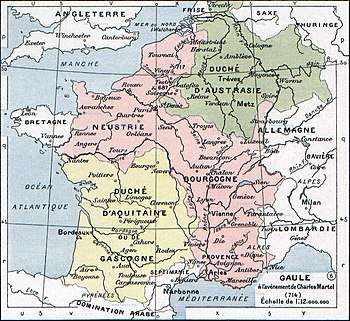Battle of Lucofao
The Battle of Lucofao (or Bois-du-Fays) was the decisive engagement of the civil war that afflicted the Frankish kingdoms during and after the reign of Dagobert II (676–79). In the battle, the Neustrian forces of Theuderic III and his majordomo Ebroin defeated the forces of Austrasia under the dukes Pippin and Martin.

The location of the battle, Lucofao or Locofao, is now part of Sévigny-Waleppe, not far from Rethel, in the Ardennes.[1][2] The name—in French Bois-du-Fays—comes from Latin lucus fagus, beech grove. The toponym Latofao, from latus fagus, beech space, is closely related.[3]
The date of the battle may be placed any time after the death of Childeric II in 675 and before the death of Ebroin in 680. Traditionally, it is placed in early 680, after the death of Dagobert II, who died in late 679 (on December 23 according to later martyrologies), and before the death of Ebroin, who was probably dead by May 15.[4] The chronological indication is the same in both of the primary sources, the Liber Historiae Francorum and the continuation of the Chronicle of Fredegar: the battle took place "after the death of Wulfoald and the disappearance of the kings".[5][6] The date of Wulfoald's death and the identity of the deceased kings, however, are uncertain and scholars have reached different conclusions. If Childeric II and Chlothar III (673) are meant, as seems more likely, then the battle took place during the reign of Dagobert II in Austrasia. If, on the other hand, Childeric II and Dagobert II are the kings referred to, then the traditional date is accurate.[1][4] Paul Fouracre and Richard Gerberding propose a date of September 679, shortly before Dagobert's assassination.[7]
Both the Chronicle of Fredegar and the Liber Historiae Francorum leave no doubt that the battle was a very large encounter for its time.[1][4] It was the first piece of serious fighting between Franks since the civil war of Brunhild (d. 613) and Chlothar II (d. 629) three generations earlier.[7]
The Austrasians under Pippin and Martin initiated the conflict, "stirred up war against King Theuderic" in the words of Fredegar.[5] The language of the Liber Historiae Francorum suggests that there army was composed primarily of levies.[8] This increases the likelihood that the battle took place while Dagobert II was alive, given the importance of a legitimate Merovingian king for raising armies. In this instance, Pippin and Martin's army was in fact fighting in the name of Dagobert II.[4]
Despite the fact that they had initiated the war, Pippin and Martin were defeated by their Neustrian counterpart, Ebroin, who followed up his victory by laying waste the entire region.[5] Pippin and Martin fled, the latter taking refuge in Laon, from which he was lured out by Ebroin with false assurances. He came to the villa of Ecry (now Asfeld) for what he evidently believed would be negotiations, but he and his supporters were killed.[9][10]
In hindsight, the battle of Lucofao was a major setback in the rise of Pippin and his family to a place of preeminence in the Frankish kingdoms. His death in 714 sparked a civil war over his succession, and in 751 his grandson and namesake Pippin the Short deposed the last Merovingian and had himself crowned king, inaugurating the Carolingian dynasty. The Liber Historiae Francorum, which was written in 727 from a Neustrian perspective, gives greater prominence to the Neustrian victory at Lucofao than to the Austrasian victory at the battle of Tertry (687).[11] The Annales Mettenses Priores, written as a piece of Carolingian (Pippinid) propaganda, does not even mention the battle.[1][12]
Primary sources
|
Liber Historiae Francorum, chapter 46 |
|
Continuations of the Chronicle of Fredegar, chapter 3 |
Notes
- Bachrach (2001), pp. 7–8.
- Lusse (1992), p. 256.
- Nègre (1987), p. 19.
- Gerberding (1987), pp. 79–84.
- Wallace-Hadrill (1960), p. 83.
- Fouracre & Gerberding (1996), p. 91.
- Fouracre & Gerberding (1996), p. 23.
- Bachrach (2001), p. 264 n. 48: infinita turba populi Austrasii.
- Wood (1994), p. 234.
- Bachrach (2001), p. 264 n. 52.
- Gerberding (1987), p. 94.
- Fouracre & Gerberding (1996), p. 83.
Bibliography
- Bachrach, Bernard S. (2001). Early Carolingian Warfare: Prelude to Empire. University of Pennsylvania Press.CS1 maint: ref=harv (link)
- Fouracre, Paul J.; Gerberding, Richard A., eds. (1996). Late Merovingian France: History and Hagiography, 640–720. Manchester University Press.CS1 maint: ref=harv (link)
- Gerberding, Richard A. (1983). A Critical Study of the Liber historiae Francorum (Ph.D. dissertation). Oxford University.CS1 maint: ref=harv (link)
- Gerberding, Richard A. (1987). The Rise of the Carolingians and the Liber Historiae Francorum. Oxford University Press.CS1 maint: ref=harv (link)
- Lusse, Jackie (1992). Naissance d'une cité: Laon et le Laonnois du Ve au Xe siècle. Presses universitaires de Nancy.CS1 maint: ref=harv (link)
- Nègre, Ernest (1987). "Toponymie du hêtre en France". Nouvelle revue d'onomastique (9–10): 19–25.CS1 maint: ref=harv (link)
- Wallace-Hadrill, J. M., ed. (1960). The Fourth Book of the Chronicle of Fredegar with its Continuations. Thomas Nelson and Sons.CS1 maint: ref=harv (link)
- Wood, Ian N. (1994). The Merovingian Kingdoms, 450–751. Longman.CS1 maint: ref=harv (link)